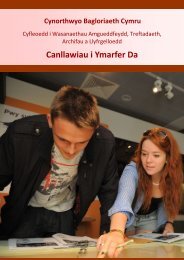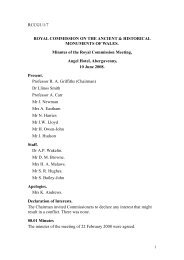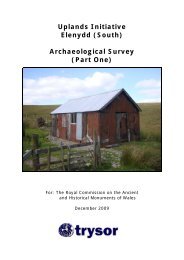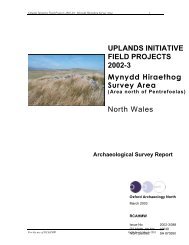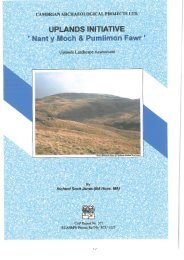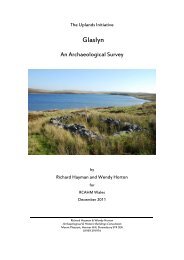Foel Goch Archaeological Survey - Royal Commission on the ...
Foel Goch Archaeological Survey - Royal Commission on the ...
Foel Goch Archaeological Survey - Royal Commission on the ...
You also want an ePaper? Increase the reach of your titles
YUMPU automatically turns print PDFs into web optimized ePapers that Google loves.
Uplands Initiative Field Projects 2011-12: <str<strong>on</strong>g>Foel</str<strong>on</strong>g> <str<strong>on</strong>g>Goch</str<strong>on</strong>g> <str<strong>on</strong>g>Survey</str<strong>on</strong>g> Report 22<br />
6. CONCLUSION<br />
6.1 DISCUSSION<br />
6.1.1 The survey has identified a low/moderate density of sites widely distributed<br />
throughout <strong>the</strong> study area, most of which were associated with post-medieval stock<br />
management, agriculture and habitati<strong>on</strong>, although <strong>the</strong>re were also significant<br />
c<strong>on</strong>centrati<strong>on</strong>s of prehistoric funerary/ritual sites. Previous surveys have highlighted<br />
a relatively small number of sites whilst <strong>the</strong> present survey has recorded a substantial<br />
increase <strong>on</strong> <strong>the</strong> previous surveys; although this was skewed by a landscape survey<br />
undertaken within <strong>the</strong> excluded area. The present survey has increased <strong>the</strong> number<br />
of identified m<strong>on</strong>uments within <strong>the</strong> NMR/HER by 386%.<br />
6.1.2 Prehistoric Funerary/Ritual Sites: a pair of m<strong>on</strong>uments c<strong>on</strong>sisting of a ring cairn<br />
and kerbed cairn circle as well as two round cairns had previously been recorded,<br />
but <strong>the</strong> present survey has provided evidence for a wide distributi<strong>on</strong> of five fur<strong>the</strong>r<br />
groups of m<strong>on</strong>uments, with <strong>on</strong>e c<strong>on</strong>taining a definite ring cairn. Many of <strong>the</strong><br />
m<strong>on</strong>uments were located ei<strong>the</strong>r <strong>on</strong> a plateau <strong>on</strong> <strong>the</strong> lower flanks of <strong>the</strong> hills, or <strong>on</strong><br />
sheltered ground just below <strong>the</strong> summits of <strong>the</strong> hills. The ring cairns may originally<br />
have had a ritual ra<strong>the</strong>r than a funerary functi<strong>on</strong> and within <strong>the</strong> group of round<br />
cairns <strong>the</strong>re is fragmentary evidence of internal architecture, such as possible cists,<br />
as well as external banks and ditches, and kerbing which are comm<strong>on</strong> for examples<br />
in <strong>the</strong> regi<strong>on</strong> (Lynch 2002, 21). Most, if not all, have been disturbed by antiquarian<br />
investigati<strong>on</strong> or agricultural clearance. The grouping of cairns into both pairs and<br />
larger cemeteries, and often associated with prestige m<strong>on</strong>uments, such as st<strong>on</strong>e<br />
circles and ring cairns, is often seen in <strong>the</strong> wider regi<strong>on</strong> (Lynch 1993 and 1995; OA<br />
North 2005a, Silvester 2003 and 2011).<br />
6.1.3 Medieval to Post-Medieval Agriculture and Settlement: <strong>on</strong>ly two sites of probable<br />
medieval date have previously been discovered within <strong>the</strong> study area, <strong>the</strong> most likely<br />
being a definite l<strong>on</strong>ghouse at Cefn Caer Euni (NMR 519352). <strong>the</strong> o<strong>the</strong>r site being<br />
<strong>the</strong> putative hermitage of Eglwys-Anne. There seems to be no fur<strong>the</strong>r evidence for<br />
<strong>the</strong> identificati<strong>on</strong> of <strong>the</strong> ecclesiastical site here o<strong>the</strong>r than <strong>the</strong> ‘eglwys/church’ and<br />
pers<strong>on</strong>al name, presumably of a saint or hermit. <str<strong>on</strong>g>Archaeological</str<strong>on</strong>g> evidence for<br />
medieval/early post-medieval occupati<strong>on</strong> at ecclesiastical sites, such as granges, is<br />
well known within <strong>the</strong> regi<strong>on</strong> (Silvester 2006) and in <strong>the</strong> vicinity of <strong>the</strong> study area<br />
sites were investigated in <strong>the</strong> Brenig Valley that revealed sixteenth century pottery<br />
and occupati<strong>on</strong>al debris (Lynch 1993, 179).<br />
6.1.4 The current survey identified a probable l<strong>on</strong>ghouse set within a sub-oval enclosure<br />
at Waen Fawr <strong>on</strong> Cefn Caer Euni, and nearby are <strong>the</strong> remains of a possible Ty<br />
Unnos enclosure (NMR 519346 and 412788). Three sites associated with probable<br />
upland transhumant domestic occupati<strong>on</strong> with associated ancillary stock enclosures<br />
were identified. The first two were located al<strong>on</strong>g a mountain trackway <strong>on</strong> <strong>the</strong> west<br />
side of Moel Emoel (NMR 519213-519214), both of which had ancillary stock<br />
enclosures. The distributi<strong>on</strong> of such sites c<strong>on</strong>formed to <strong>the</strong> pattern of dispersed<br />
singular sites or small settlement groups <strong>on</strong> what would have been pre-Enclosure<br />
Act open comm<strong>on</strong> land. Such a pattern is documented elsewhere in <strong>the</strong> regi<strong>on</strong><br />
(Davies 1973, 57; Fig 2). The mountains formed suitable areas for both legal and<br />
For <strong>the</strong> use of RCAHMW © OA North: February 2012




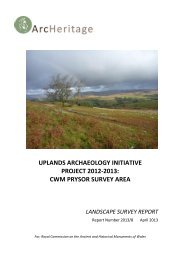
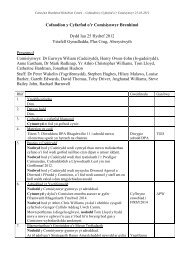
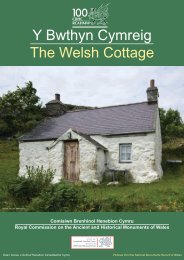

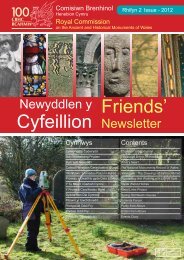
![The Source of the Usk Walk [2012 PDF]](https://img.yumpu.com/49285699/1/190x245/the-source-of-the-usk-walk-2012-pdf.jpg?quality=85)

